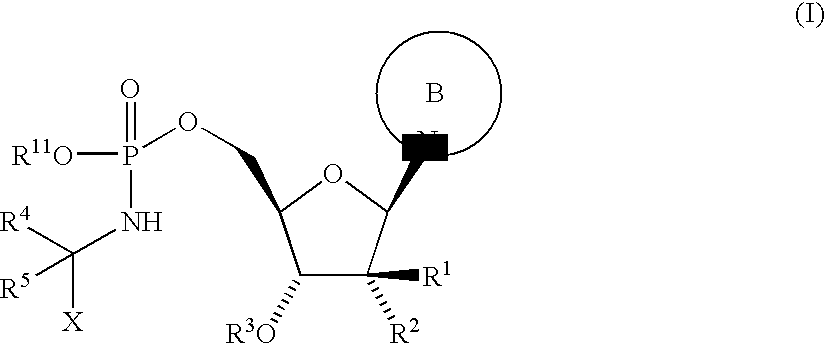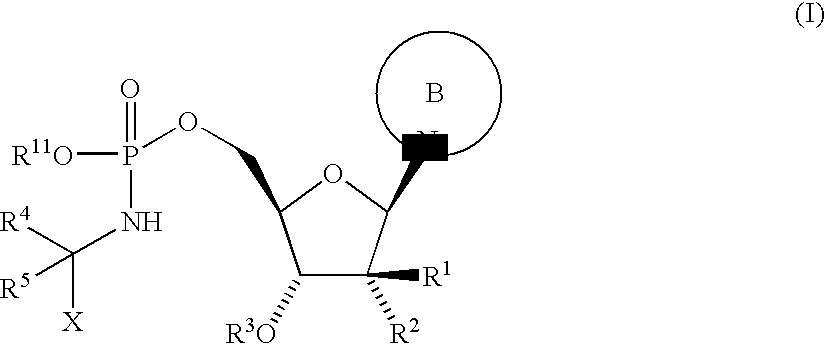Antiviral Agents
a technology of antiviral agents and phosphoramidates, which is applied in the direction of biocide, sugar derivatives, plant growth regulators, etc., can solve the problems of no established vaccine for hcv, limited clinical benefit, and treatment of hcv infection, and achieves less susceptible, efficient target cell penetration, and wide therapeutic index
- Summary
- Abstract
- Description
- Claims
- Application Information
AI Technical Summary
Benefits of technology
Problems solved by technology
Method used
Image
Examples
reference example 1
(R6=Et)
Step 1: 5′-O-[[[(1S)-2-ethoxy-1-methyl-2-oxo ethyl]amino](9H-fluoren-9-ylmethoxy)phosphinyl]-2′-C-methylcytidine
[0182]Bisphenyl phosphite was dissolved in pyridine (0.3 M) and a solution of fluorenylmethyl alcohol in pyridine (0.3 M) was added. The mixture was stirred at 0° C. for 20 min. Then a solution of 2′-C-methyl-cytidine in pyridine (0.3M) was added at 0° C. The resulting solution was warmed to 40° C. and stirred for 1 h at this temperature. The solvent was evaporated and the residue dissolved in DMA (0.19M). The resulting solution was added to a solution of L-alanine-ethylester hydrochloride (1.2 eq.) and Et3N (2.0 eq.) in iPrOH:CCl4 (0.24 M, 10:1). The mixture was stirred for 10 min at 0° C. and then the solvent was evaporated. The residue was dissolved in EtOAc and water. The aqueous phase was extracted three times with EtOAc, the combined organic phases were washed with brine and dried over Na2SO4. The crude product was purified by RP-HPLC (stationary phase: column...
example 2
(R6=2PrPen)
Step 1: 2′-C-methyl-2′,3′-O-(1-methylethylidene)-cytidine
[0184]2′-C-Methylcytidine was diluted with acetone (0.04M) and p-toluensulfonic acid and 2,2-dimethoxypropane were added. The resulting slurry was stirred for 24 h at RT. The solvent was evaporated, the residue was dissolved in MeOH and Amberlite A-26 (previously washed with 2N NaOH and H2O) was added. The resulting mixture was stirred for 2 h. The Amberlite was filtered off and the solution was evaporated. The crude product was purified by column chromatography on silica gel (DCM:MeOH=9:1) to give the desired product as a white powder. 1H NMR (300 MHz, CD3OD) δ 7.96 (d, J 7.56, 1H), 6.18 (s, 1H), 5.90 (d, J 7.56, 1H), 4.51-4.48 (m, 1H), 4.28-4.23 (m, 1H), 3.86 (dd, J 12.12, 3.04, 1H), 3.78 (dd, J 12.12, 3.52, 1H), 1,59 (s, 3H), 1.43 (s, 3H), 1.25 (s, 3H); MS (ES+) m / z 298 (M+H)+
Step 2: 5′-O-[[[(1S)-1-methyl-2-oxo-2-[propylpentyl)oxy]ethyl]amino]phenylmethoxy)phosphinyl]-2′-C-methyl-2′,3′-O-(1-methylethylidene)-cyti...
example 3
(R12=4-Hep)
Step 1: 5′-O-[[[2-[(1-oxo-2-propylpentyl)oxy]ethyl]amino]phenylmethoxy)phosphinyl]-2′-C-methyl-2′,3′-O-(1-methylethylidene)-cytidine
[0193]2′-C-Methyl-2′,3′-O-(1-methylethylidene)-cytidine (prepared as described in Step 1, Example 2) was diluted with pyridine (0.67 M) in presence of molecular sieves. The resulting solution was cooled to 0° C., diphenylphosphite (80%, 1.3 eq.) was added, and the mixture was stirred for 1 h at 0° C. To this solution, benzyl alcohol (2.0 eq) was added and the mixture was stirred at RT for 1 h. The solvent was evaporated and the residue dissolved in THF:CCl4 (0.08M, 12:1). The resulting solution was cooled to 0° C., Et3N (7.0 eq.) and a solution of 2-aminoethyl 2-propylpentanoate hydrochloride (1.3 eq.) in iPrOH-THF were added. The mixture was stirred for 30 min at 0° C. and then the salts were filtered. The resulting solution was evaporated and then diluted with EtOAc and water. The aqueous phase was separated and extracted three times with E...
PUM
| Property | Measurement | Unit |
|---|---|---|
| Pharmaceutically acceptable | aaaaa | aaaaa |
Abstract
Description
Claims
Application Information
 Login to View More
Login to View More - R&D
- Intellectual Property
- Life Sciences
- Materials
- Tech Scout
- Unparalleled Data Quality
- Higher Quality Content
- 60% Fewer Hallucinations
Browse by: Latest US Patents, China's latest patents, Technical Efficacy Thesaurus, Application Domain, Technology Topic, Popular Technical Reports.
© 2025 PatSnap. All rights reserved.Legal|Privacy policy|Modern Slavery Act Transparency Statement|Sitemap|About US| Contact US: help@patsnap.com



